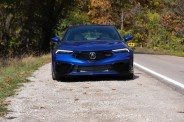If your car has an automatic transmission, the different positions you can shift into follow a specific pattern: P-R-N-D, usually followed by either a couple of lower gear options or the chance to shift it into a manual control mode. In case you’ve never driven (or, somehow, only driven cars with manual transmissions, in which place, god bless you), those four letters stand for Park, Reverse, Neutral and Drive — or, in layman’s terms, Stopped, Backwards, Free-Rolling and Forwards.
You’ve probably shifted from Park to Drive a hundred thousand times, and from Drive to Reverse nearly as many. But in all those times, have you ever stopped to wonder: Gee, why is it that every car’s shifter seems to go from Reverse to Neutral to Drive?
Well, there’s actually a very good reason: the United States government says so.
Older shifters used a P-N-D-L-R arraingement
When the automatic transmission was young, carmakers would often set up their own shifters however they damn well felt like it. One common layout, found in General Motors and Chrysler models, among others, placed Reverse at the far end of the shifter, past Neutral, Drive and the lower gears. In one sense, it made sense; after all, you want Reverse to be easy to find, so why not put it at the very end of the shifter?
The problem that arose, however, was one of user error: people attempting to shift into a low forward gear would wind up overshooting into Reverse without realizing it, or vice versa. Given the mass of, say, a ’59 Eldorado, traveling suddenly in the wrong direction could result in very unpleasant consequences for any persons, animals or objects that happened to be in the way.







